SENIORS ECOSYSTEM
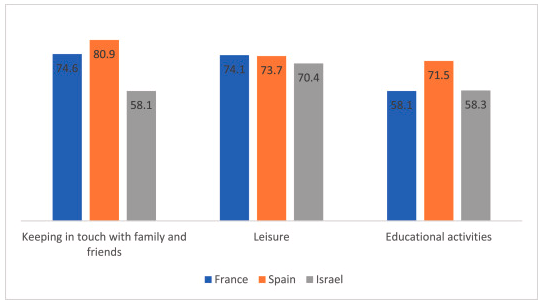
Elimelech, O. C., Ferrante, S., Josman, N., Meyer, S., Lunardini, F., Gómez-Raja, J., … & Rosenblum, S. (2022).
Technology use characteristics among older adults during the COVID-19 pandemic: A cross-cultural survey.
Technology in Society, 71, 102080.
https://www.sciencedirect.com/science/article/pii/S0160791X22002214
Personal computers, tablets, and smartphones may support older adults’ engagement when people are required to stay home and opportunities to engage in meaningful activities are reduced during the COVID-19 period. This study aims to screen older adults’ technology-use characteristics across social, leisure, and education domains during the COVID-19 pandemic from a crosscultural viewpoint. The sample included 576 participants aged 60 and older from France (n = 62), Spain (n = 110), and Israel (n = 404). Participants completed the technology-use survey, which consists of questions about their facilities, technology usability, need for adaptations to support technology use, and changes in technology use since COVID-19. Significant differences were found between countries in facilities, χ2 (2) = 25.16, p < .001, and usability, χ2 (2) = 64.14, p < .001, across the three domains. Furthermore, 34% of technological usability was predicted by country and facilities, F (4, 568) = 72.39, p < .001. Participants noted a willingness to use technology if it was adapted for social (61%–73%), leisure (51%–71%), or educational (67%–76%) activities and that they devoted substantially more time to technology across domains (>58%) due to COVID-19. These findings highlight culture and facilities as factors that play an imperative role in supporting and enhancing the usability of technology among older adults.
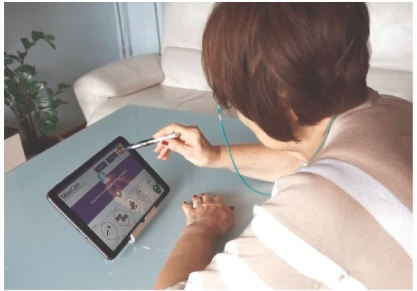
Luperto, M., Basilico, N., Vuono, A., Cid, M., Cesari, M., Ferrante, S., & Borghese, N. A. (2021, May).
A community-based activity center to promote social engagement and counteract decline of elders living independently.
In AIxIA 2020–Advances in Artificial Intelligence: XIXth International Conference of the Italian Association for Artificial Intelligence, Virtual Event, November 25–27, 2020, Revised Selected Papers (pp. 388-422). Cham: Springer International Publishing.
https://link.springer.com/chapter/10.1007/978-3-030-77091-4_24
Global ageing of the population is deeply affecting the everyday lives of the frailest, by exposing them to increasing isolation and loneliness that, in turn, can cause or accelerate cognitive decline. The use of digital technologies and, in particular, social networks can be an effective tool to mitigate this phenomenon, by helping older age people to stay connected and be stimulated in the cognitive and physical sphere. In this work, we present a platform called Community-Based Activity Center (CBAC) a central tool developed within the scope of the European project MoveCare, an effort to leverage intelligent Ambient-Assisted Living technologies to promote active well-being for the elderly. CBAC conveys cross-domain stimulation in the cognitive, physical, and social scopes by providing a virtual community where different types of activities can be carried out alone or together with caregivers, members of the family, friends, and peers. We followed a modular approach, developing a flexible platform that be integrated with AI-based recommendations and that allows for transparent monitoring. The effectiveness of our platform has been extensively tested in a preliminary usability test and in a pilot experimental campaign that involved 25 selected seniors on a time span of 10 weeks.
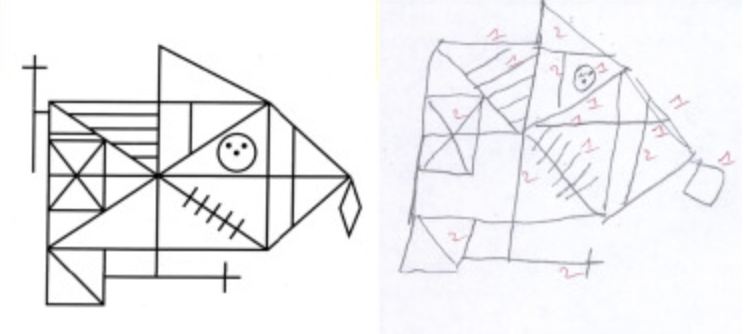
Di Febbo, D., Ferrante, S., Baratta, M., Luperto, M., Abbate, C., Trimarchi, P. D., … & Matteucci, M. (2023).
A decision support system for Rey–Osterrieth complex figure evaluation.
Expert Systems with Applications, 213, 119226.
https://www.sciencedirect.com/science/article/pii/S0957417422022448
Objective: The Rey Osterrieth complex figure (ROCF) is one of the most used neuropsychological tests for the assessment of mild cognitive impairment (MCI) and dementia. In the copy test, the patient has to draw a replica of a 18-pattern image and the outcome is a score based on the accuracy of the overall drawing. The standard scoring system however have limitations related to its subjective nature and its inability to evaluate other cognitive domains than constructional abilities. Previous works addressed those problems by proposing tablet-based automated evaluation systems. Even promising, such methods are still far away from clinical validation and translation. In this work, we developed a decision support system (DSS) for the evaluation of the ROCF copy test in the common practice using retrospective information from previously performed drawings. The goal of our system was to support the professionals providing a qualitative judgement for each of the 18 patterns, estimating the most probable diagnosis for the patient, and identifying the main signs associated to the obtained diagnosis.
Methods: A total of 250 human evaluated ROCF copies were scanned from 57 healthy subjects, 131 individuals with MCI, and 62 individuals with dementia. The images were pre-processed and analysed using both computer vision and deep learning techniques to assign a qualitative label to the 18 patterns. Then, the 18 labels were used as features in 3 binary (healthy VS MCI, healthy VS dementia, MCI VS dementia) and a 3-class classifications with model explanation (SHAP).
Results: Very good to excellent performance were obtained in all the diagnosis classification tasks. Indeed, an accuracy of about 85%, 91%, and 83% was obtained in discriminating healthy subjects from MCI, healthy subjects from dementia and MCI from dementia respectively. An accuracy of 73% was achieved in the 3-class classification. The model explanation showed which patterns are responsible for each prediction and how the importance of some patterns changes according to the severity of the cognitive decline.
Significance: The proposed DSS enriches the standard evaluation and interpretation of the ROCF copy test. Being trained with retrospective knowledge, the performance of the DSS can be further enhanced by extending the dataset with existing ROCF copies.
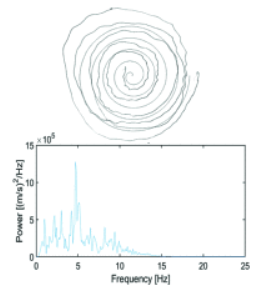
Toffoli, S., Lunardini, F., Parati, M., Gallotta, M., De Maria, B., Dell’Anna, M. E., & Ferrante, S. (2021, November).
A smart ink pen for spiral drawing analysis in patients with Parkinson’s disease.
In 2021 43rd Annual International Conference of the IEEE Engineering in Medicine & Biology Society (EMBC) (pp. 6475-6478). IEEE.
https://ieeexplore.ieee.org/abstract/document/9629681
Handwriting skills could be highly impaired in patients affected by Parkinson’s disease (PD), and for this reason its analysis had always been considered relevant. In handwriting assessment, Archimedes spiral drawing is one of the most proposed tasks, due to its peculiar shape and ease of execution. In the last decades, digitizing tablets had been widely employed for the evaluation of the spiral performance, providing a cheap and non-invasive way to gather quantitative information, to be combined with the classical clinical examination. Despite this advantage, such approach cannot easily be adopted in an unsupervised scenario and lacks the natural feel of the traditional pen-and-paper approach. This work aims at overcoming these limitations by employing a smart ink pen, designed to write on paper and instrumented with inertial and force sensors, to automatically collect data related to spiral drawing execution of PD patients (n=30) and age-matched healthy controls (n=30). From the raw data, several time and frequency domains features were extracted and compared between the groups. The statistical analysis revealed some significant differences, showing less smooth acceleration and force profiles for PD patients. However, given the heterogeneous symptoms presented by the PD cohort, a detailed analysis of exemplifying PD patients was conducted, showing the ability of Archimedes spiral drawing to capture and quantify PD characteristic features.Clinical Relevance— Among the first clinical manifestations of the pathology, handwriting impairment appears in PD patients. It is often underestimated and not investigated properly. This easy-to-use tool could be very useful as a large-scale screening, but also for treatment efficacy evaluation and for the identification of PD subgroups.
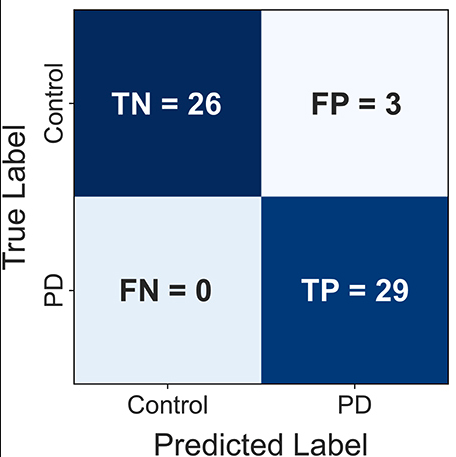
Toffoli, S., Lunardini, F., Parati, M., Gallotta, M., De Maria, B., Longoni, L., … & Ferrante, S. (2023).
Spiral drawing analysis with a smart ink pen to identify Parkinson’s disease fine motor deficits.
Frontiers in Neurology, 14, 181.
https://www.frontiersin.org/articles/10.3389/fneur.2023.1093690/full
Introduction: Since the uptake of digitizers, quantitative spiral drawing assessment allowed gaining insight into motor impairments related to Parkinson’s disease. However, the reduced naturalness of the gesture and the poor user-friendliness of the data acquisition hamper the adoption of such technologies in the clinical practice. To overcome such limitations, we present a novel smart ink pen for spiral drawing assessment, intending to better characterize Parkinson’s disease motor symptoms. The device, used on paper as a normal pen, is enriched with motion and force sensors.
Methods: Forty-five indicators were computed from spirals acquired from 29 Parkinsonian patients and 29 age-matched controls. We investigated between-group differences and correlations with clinical scores. We applied machine learning classification models to test the indicators ability to discriminate between groups, with a focus on model interpretability.
Results: Compared to control, patients’ drawings were characterized by reduced fluency and lower but more variable applied force, while tremor occurrence was reflected in kinematic spectral peaks selectively concentrated in the 4–7 Hz band. The indicators revealed aspects of the disease not captured by simple trace inspection, nor by the clinical scales, which, indeed, correlate moderately. The classification achieved 94.38% accuracy, with indicators related to fluency and power distribution emerging as the most important.
Conclusion: Indicators were able to significantly identify Parkinson’s disease motor symptoms. Our findings support the introduction of the smart ink pen as a time-efficient tool to juxtapose the clinical assessment with quantitative information, without changing the way the classical examination is performed.
Toffoli, S., Lomurno, E., Lunardini, F., Carmen, G., Pilar, C., Stefania, F., … & Ferrante, S. (2022).
Activity and Age Classification from Handwritten Samples Acquired with a Smart Ink Pen.
In BHI 2022, International Conference on Biomedical and Health Informatics.
https://re.public.polimi.it/bitstream/11311/1220596/1/E_A_final%20%281%29.pdf
Free writing and drawing (no constraints on content) data were acquired from 21 young (age = 30.1 ± 5.6 years) and 9 older adults (age = 81.3 ± 3.9), with a smart ink pen. The acquired data were processed to extract the indicators characterizing the performance in the domains of time, fluency, exerted force, pen inclination, tremor amplitude, frequency distribution and regularity. The indicators were used to solve two classification problems: activity and age classification. The latter considered writing data only. Five algorithms were tested with a nested k-fold cross validation approach: logistic regression, support vector machines, k-nearest neighbors, random forest and Catboost. Model performances were measured through accuracy, precision, recall, f1-score and specificity.
The best performances were obtained by a Catboost classifier in both problems. In the activity classification, the model achieved accuracy 93.33%, precision 93.02%, recall 96.77%, f1-score 94.86% and specificity 87.32% on the test set, proving the indicators ability to distinguish writing from drawing. In the age classification based on writing samples, accuracy 90.00%, precision 87.50%, recall 77.78%, f1-score 82.35% and specificity 95.24% were obtained (test set).
CHILDREN ECOSYSTEM
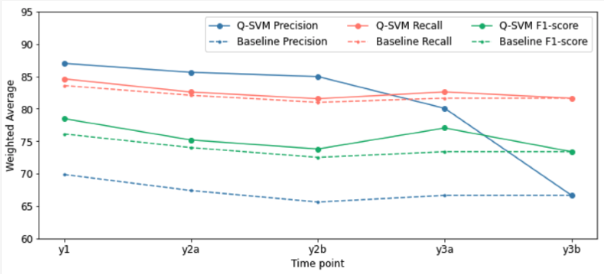
Lomurno, E., Dui, L. G., Gatto, M., Bollettino, M., Matteucci, M., & Ferrante, S. (2023).
Deep Learning and Procrustes Analysis for Early Dysgraphia Risk Detection with a Tablet Application.
Life, 13(3), 598.
https://www.mdpi.com/2075-1729/13/3/598
Dysgraphia is a neurodevelopmental disorder specific to handwriting. Classical diagnosis is based on the evaluation of speed and quality of the final handwritten text: it is therefore delayed as it is conducted only when handwriting is mastered, in addition to being highly language-dependent and not always easily accessible. This work presents a solution able to anticipate dysgraphia screening when handwriting has not been learned yet, in order to prevent negative consequences on the individuals’ academic and daily life. To quantitatively measure handwriting-related characteristics and monitor their evolution over time, we leveraged the Play-Draw-Write iPad application to collect data produced by children from the last year of kindergarten through the second year of elementary school. We developed a meta-model based on deep learning techniques (ensemble techniques and Quasi-SVM) which receives as input raw signals collected after a processing phase based on dimensionality reduction techniques (autoencoder and Time2Vec) and mathematical tools for high-level feature extraction (Procrustes Analysis). The final dysgraphia classifier can identify “at-risk” children with 84.62% Accuracy and 100% Precision more than two years earlier than current diagnostic techniques.
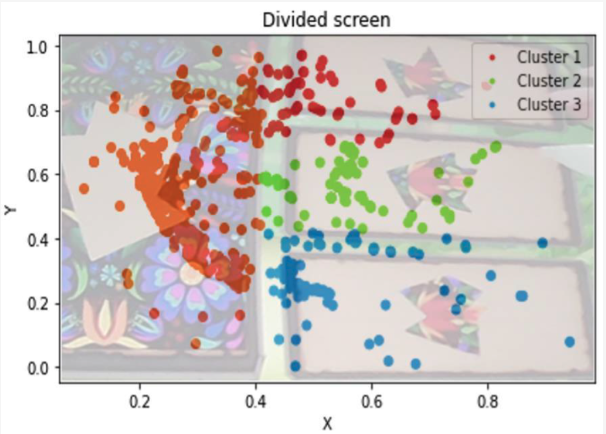
Piazzalunga, C., Dui, L. G., Termine, C., Bortolozzo, M., Matteucci, M., & Ferrante, S. (2023).
Investigating Visual Perception Impairments through Serious Games and Eye Tracking to Anticipate Handwriting Difficulties.
Sensors, 23(4), 1765.
https://www.mdpi.com/1424-8220/23/4/1765
Dysgraphia is a learning disability that causes handwritten production below expectations. Its diagnosis is delayed until the completion of handwriting development. To allow a preventive training program, abilities not directly related to handwriting should be evaluated, and one of them is visual perception. To investigate the role of visual perception in handwriting skills, we gamified standard clinical visual perception tests to be played while wearing an eye tracker at three difficulty levels. Then, we identified children at risk of dysgraphia through the means of a handwriting speed test. Five machine learning models were constructed to predict if the child was at risk, using the CatBoost algorithm with Nested Cross-Validation, with combinations of game performance, eye-tracking, and drawing data as predictors. A total of 53 children participated in the study. The machine learning models obtained good results, particularly with game performances as predictors (F1 score: 0.77 train, 0.71 test). SHAP explainer was used to identify the most impactful features. The game reached an excellent usability score (89.4 ± 9.6). These results are promising to suggest a new tool for dysgraphia early screening based on visual perception skills
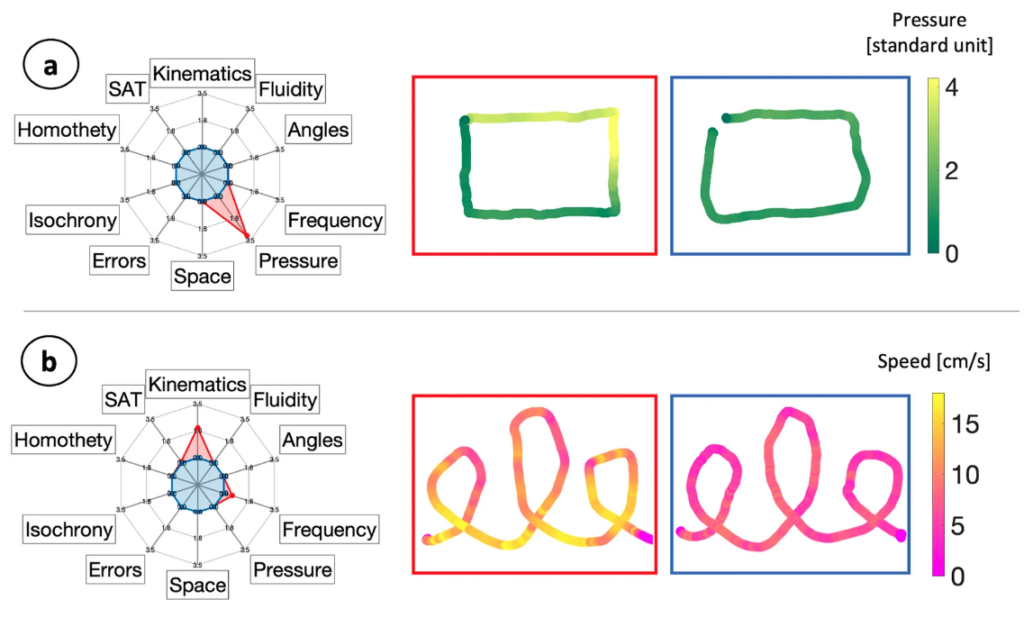
Dui, L. G., Lomurno, E., Lunardini, F., Termine, C., Campi, A., Matteucci, M., & Ferrante, S. (2022).
Identification and characterization of learning weakness from drawing analysis at the pre-literacy stage.
Scientific Reports, 12(1), 21624.
https://www.nature.com/articles/s41598-022-26038-9
Handwriting learning delays should be addressed early to prevent their exacerbation and long-lasting consequences on whole children’s lives. Ideally, proper training should start even before learning how to write. This work presents a novel method to disclose potential handwriting problems, from a pre-literacy stage, based on drawings instead of words production analysis. Two hundred forty-one kindergartners drew on a tablet, and we computed features known to be distinctive of poor handwriting from symbols drawings. We verified that abnormal features patterns reflected abnormal drawings, and found correspondence in experts’ evaluation of the potential risk of developing a learning delay in the graphical sphere. A machine learning model was able to discriminate with 0.75 sensitivity and 0.76 specificity children at risk. Finally, we explained why children were considered at risk by the algorithms to inform teachers on the specific weaknesses that need training. Thanks to this system, early intervention to train specific learning delays will be finally possible.
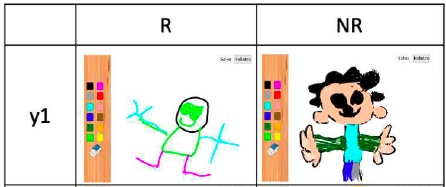
Drawings examples from children at risk (column R) and not at risk (column NR)
Dui, L. G., Toffoli, S., Speziale, C., Termine, C., Matteucci, M., & Ferrante, S. (2022, September).
Can Free Drawing Anticipate Handwriting Difficulties? A Longitudinal Study.
In 2022 IEEE-EMBS International Conference on Biomedical and Health Informatics (BHI) (pp. 1-4). IEEE.
https://ieeexplore.ieee.org/document/9926884
Handwriting difficulties need to be addressed early to avoid several problems to children, both at school and in everyday life, but dysgraphia diagnosis cannot be performed before handwriting maturation. To solve this issue, we hypothesize that the analysis of drawings produced in a pre-literacy stage can predict handwriting problems that will occur years later. We designed a three-year longitudinal study from the last year of kindergarten to the end of second grade with two aims: (1) to longitudinally assess the evolution of drawing features, and (2) to understand if the features collected at pre-literacy can predict future handwriting problems. Hence, features were tested for statistically significant variation among the five time points available to assess their longitudinal evolution in time. Moreover, we trained machine learning models to select the most important features collected at pre-literacy and to assess their predictive capabilities, with dysgraphia risk assessed at the end of second grade. 202 children completed the longitudinal study. We found that 81% of the feature was sensitive to longitudinal maturation and that it is possible to predict the difficulties with a weighted area under the precision-recall curve of 0.72. This is a step forward towards an early intervention for handwriting problems.

Game example. Form constancy: the ability to recognize a shape when size, color or orientation
changes.
Piazzalunga, C., Dui, L. G., Termine, C., Bortolozzo, M., Ferrante, S., & Matteucci, M. (2021).
A serious game to anticipate handwriting difficulties screening through visual perception assessment.
In PROCEEDINGS OF THE EUROPEAN CONFERENCE ON GAMES-BASED LEARNING (Vol. 2021, pp. 916-920). Dechema eV.
https://re.public.polimi.it/handle/11311/1192986
Dysgraphia is a learning disability that causes handwritten production below the expectancies. Its diagnosis is delayed until handwriting development should be completed, with the possible worsening of children’s weaknesses. To allow a preventive empowerment program, abilities not directly related to handwriting should be evaluated, and one of them is visual perception. To investigate the role of visual perception in handwriting skills, we gamified standard clinical tests of form constancy, figure-ground discrimination and visual closure exercises, to be played with an eye tracker at three difficulty levels. Then, we related game performances to a handwriting speed test. The aims of this work are: to test game usability and design effectiveness, and to preliminarily explore the relationship between visual performance and writing skills. Game performances were computed with principal component analysis, combining time-to-completion and errors in each game. A linear regression related game performance (predictors) with writing speed (target). Perceived increase in difficulty among levels was tested by means of an ANOVA. As for usability, participants answered the System Usability Scale. In total, 28 subjects – 3 children, 19 young adults and 6 older adults – participated in the study. Game scores provided a good quality of fitting (R2= 0.67, p<0.001) of handwriting speed in the regression model. ANOVA suggested that masked form constancy and visual closure games were perceived as more challenging as difficulty raised (game score significantly decreased, p<0.001), while in form constancy and figure-ground perception a learning effect was observed (game score significantly increased, p<0.001). Interesting qualitative observations emerged from eye-tracking data, drawing suggestions for exploiting ocular strategy to better investigate its role in game performance. The game reached excellent usability (92.86±5.08), which allows to confidently extend the study to a younger, more adequate sample. These results are promising to suggest a new tool for dysgraphia early screening, based on visual perception skills.
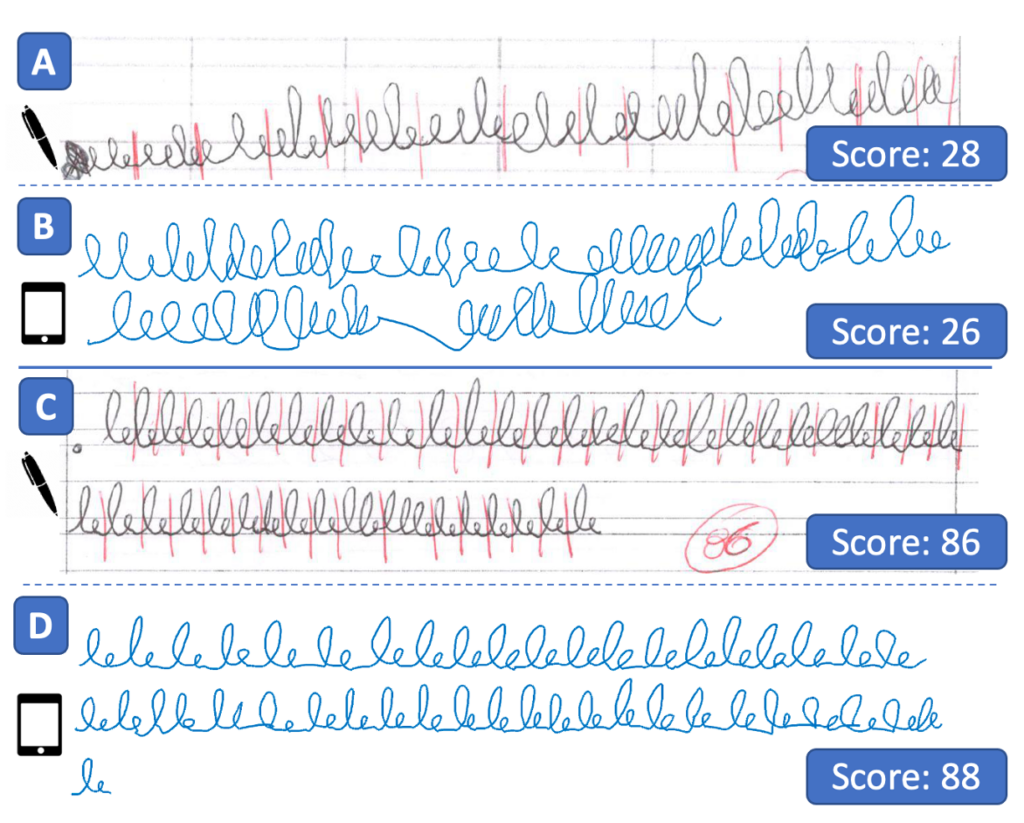
Example of the execution of test A on paper (panels a and c) and on tablet (panels b and d). Panels a and b are referred to a subject who performed poorly, Panels c and d are referred to a proficient subject. The boxes report the scores.
Dui, L. G., Calogero, E., Malavolti, M., Termine, C., Matteucci, M., & Ferrante, S. (2021, July).
Digital tools for handwriting proficiency evaluation in children.
In 2021 IEEE EMBS International Conference on Biomedical and Health Informatics (BHI) (pp. 1-4). IEEE.
https://ieeexplore.ieee.org/abstract/document/9508539
Dysgraphia negatively impacts school-aged children, but its diagnosis is still unsatisfactory. Among its criticalities, it relies on a subjective evaluation of the final product, and it can be delayed as professional consultation might be difficult to be reached. To address these problems, we proposed to leverage two digital tools, a smart ink pen, and a consumer tablet with pen and a custom app, both capable of collecting data about gesture production. The aims of this work are (1) to test usability and acceptance of such tools, (2) to assess their concurrent validity, and (3) to leverage gesture-production features to assess handwriting proficiency. The tools were tested on 52 second and third graders performing a handwriting speed test. It revealed optimal usability (SUS>95) and acceptance. The scores of the speed test were compared to normative data, revealing that they were almost superimposable, even if collection of ad hoc normative data for tablets would allow a safer comparison. Two gesture-production features, the In-air time and the Coefficient of variation of the tilt, showed good discriminatory capabilities between different levels of handwriting maturation. These findings suggest the feasibility of adopting the digital tools for an evaluation of handwriting evolution, both enriched with quantitative information, and potentially administered in a pre-clinical environment (teleconsultation or remote monitoring). This is a first step to discover potential alteration, and achieve a more targeted diagnosis for dysgraphia.
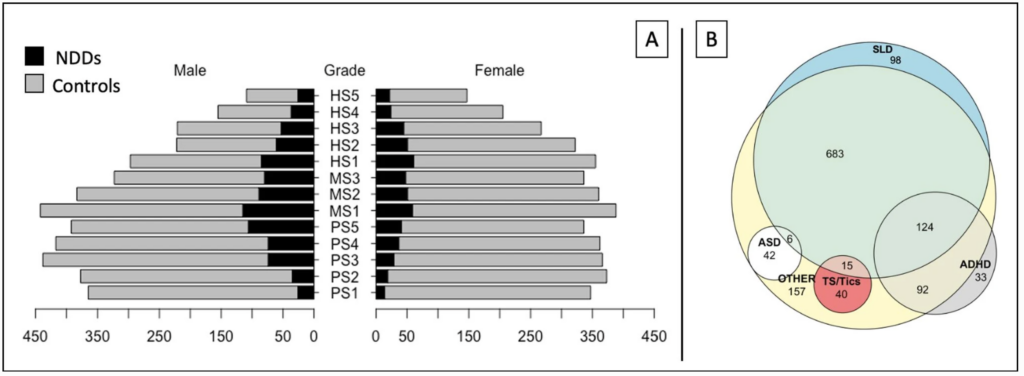
Termine, C., Dui, L. G., Borzaga, L., Galli, V., Lipari, R., Vergani, M., … & Ferrante, S. (2021).
Investigating the effects of COVID-19 lockdown on Italian children and adolescents with and without neurodevelopmental disorders: a cross-sectional study.
Current Psychology, 1-17.
https://link.springer.com/article/10.1007/s12144-021-02321-2
We conducted a cross-sectional study to compare the impact of social distancing and lifestyle changes that occurred during Corona Virus Disease 2019 (COVID-19) lockdown on children and adolescents with and without Neurodevelopmental Disorders (NDDs). An online questionnaire was administered in order to investigate the effects of NDD condition, socio-demographic status, familiar/home environment and COVID-19 exposure on their lives during a two months period of social isolation. We used logistic regression, focusing on five endpoints (remote learning, lifestyle, stress/anxiety, sociality, scolding) to define the extent of these effects. Most questions were paired up to parents and children, to verify the occurrence of agreement. 8305 questionnaires were analyzed, 1362 of which completed by NDDs and 6943 by controls. Results showed that the presence of a NDD, compared to controls, had a significant impact on: Remote Learning (i.e. subjects with NDDs experienced more difficulties in attending online classes and studying), Sociality (i.e. subjects with NDDs missed their schoolmates less), Scolding (i.e. subjects with NDDs were scolded more often) and Anxiety (i.e. subjects with NDDs were perceived by their parents as more anxious). Substantial agreement between parents and children arose from questions concerning Remote learning, Lifestyle and Scolding. The current study actually points out that having a NDD gives account for a stronger influence on school performance and on behavioral and psychological aspects, during a two months lockdown. Such results may provide useful information to governments and school authorities on how carrying through supportive strategies for youth affected by NDDs.

